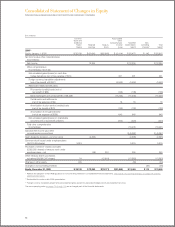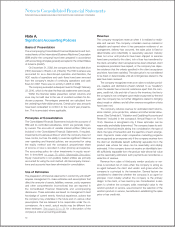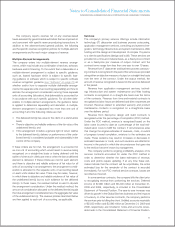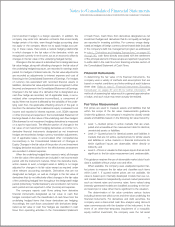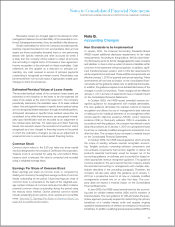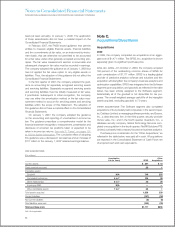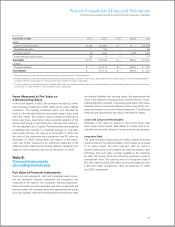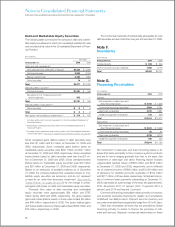IBM 2009 Annual Report Download - page 80
Download and view the complete annual report
Please find page 80 of the 2009 IBM annual report below. You can navigate through the pages in the report by either clicking on the pages listed below, or by using the keyword search tool below to find specific information within the annual report.
Notes to Consolidated Financial Statements
INTERNATIONAL BUSINESS MACHINES CORPORATION AND SUBSIDIARY COMPANIES
value of its investment in the investee adjusted using discounted
cash flows for the company’s estimate of the price that it would
receive to sell the investment to a market participant that would
consider all factors that would impact the investment’s fair value.
In determining the fair value of financial instruments, the
company considers certain market valuation adjustments to the
‘base valuations’ calculated using the methodologies described
below for several parameters that market participants would
consider in determining fair value.
• Counterparty credit risk adjustments are applied to financial
instru ments, taking into account the actual credit risk of a
counterparty as observed in the credit default swap market
to determine the true fair value of such an instrument.
• Credit risk adjustments are applied to reflect the company’s
own credit risk when valuing all liabilities measured at fair
value. The methodology is consistent with that applied in
developing counterparty credit risk adjustments, but incor-
porates the company’s own credit risk as observed in the
credit default swap market.
Certain assets are measured at fair value on a nonrecurring
basis. These assets include equity method investments that are
recognized at fair value at the end of the period to the extent that
they are deemed to be other-than-temporarily impaired. Certain
assets that are measured at fair value on a recurring basis can be
subject to nonrecurring fair value measurements. These assets
include public cost method investments that are deemed to be
other-than-temporarily impaired.
Cash Equivalents
All highly liquid investments with maturities of three months or less
at the date of purchase are considered to be cash equivalents.
Marketable Securities
Debt securities included in current assets represent securities that
are expected to be realized in cash within one year of the balance
sheet date. Long-term debt securities that are not expected to
be realized in cash within one year and alliance equity securi-
ties are included in investments and sundry assets. Debt and
marketable equity securities are considered available for sale and
are reported at fair value with unrealized gains and losses, net of
applicable taxes, recorded in other comprehensive income/(loss),
a component of equity. The realized gains and losses for available
for sale securities are included in other (income) and expense
in the Consolidated Statement of Earnings. Realized gains and
losses are calculated based on the specific identification method.
In determining whether an other-than-temporary decline in
market value has occurred, the company considers the duration
that, and extent to which, the fair value of the investment is below
its cost, the financial condition and near-term prospects of the
issuer or underlying collateral of a security; and the company’s
intent and ability to retain the security in order to allow for an
anticipated recovery in fair value. Other-than-temporary declines
in fair value from amortized cost for available for sale equity and
debt securities that the company intends to sell or would more-
likely-than-not be required to sell before the expected recovery
of the amortized cost basis are charged to other (income) and
expense in the period in which the loss occurs. For debt securi-
ties that the company has no intent to sell and believes that it
more-likely-than-not will not be required to sell prior to recovery,
only the credit loss component of the impairment is recognized
in other (income) and expense, while the remaining loss is rec-
ognized in other comprehensive income/(loss). The credit loss
component recognized in other (income) and expense is identi-
fied as the amount of the principal cash flows not expected to be
received over the remaining term of the debt security as projected
using the company’s cash flow projections.
Inventories
Raw materials, work in process and finished goods are stated at
the lower of average cost or market. Cash flows related to the
sale of inventories are reflected in net cash from operating activi-
ties from continuing operations in the Consolidated Statement
of Cash Flows.
Allowance for Uncollectible Receivables
Trade
An allowance for uncollectible trade receivables is estimated
based on a combination of write-off history, aging analysis and
any specific, known troubled accounts.
Financing
Financing receivables include sales-type leases, direct financing
leases and loans. The methodologies that the company uses to
calculate both its specific and its unallocated reserves, which
are applied consistently to its different portfolios are as follows:
SPECIFIC—The company reviews all financing receivables con-
sidered at risk on a quarterly basis. The review primarily consists
of an analysis based upon current information available about
the client, such as financial statements, news reports, published
credit ratings, current market-implied credit analysis, as well as
the current economic environment, collateral net of reposses-
sion cost and prior collection history. For loans that are collateral
dependent, impairment is measured using the fair value of the
collateral when foreclosure is probable. Using this information,
the company determines the expected cash flow for the receiv-
able and calculates a recommended estimate of the potential
loss and the probability of loss. For those accounts in which the
loss is probable, the company records a specific reserve.
UNALLOCATED—The company records an unallocated reserve
that is calculated by applying a reserve rate to its different port-
folios, excluding accounts that have been specifically reserved.
This reserve rate is based upon credit rating, probability of default,
term, asset characteristics and loss history.
78


